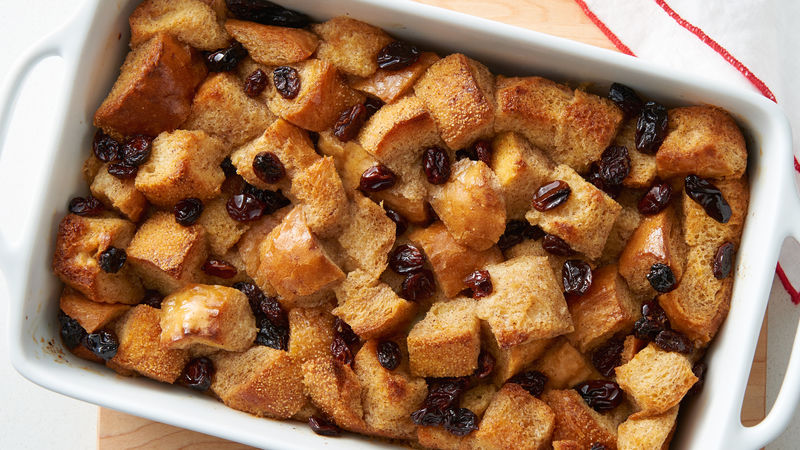Bread pudding is a bread-based dessert that is common in many countries’ cuisines. It is prepared with stale bread, milk or cream, and contains eggs, a form of fat such as oil, butter or suet. Below are some of the different ways you can heat up bread pudding.
Contents
The Oven Method
The oven is one of the best options that you can use when it comes to warming up your bread pudding. However, you may have to wait a couple of minutes for it to be done. With an oven you can get your pudding warmed up and have it almost tasting the same way it did the first time you prepared it. Normally, people reheat their pudding in the oven because you can be sure it is all the way warmed through. Make sure you tightly wrap the dish and place it in an oven safe dish and place it in the oven for about 15 minutes or so, depending on the amount of pudding you have leftover. Follow these steps to effectively warm up your pudding in the oven.
- Preheat your oven to 350°F,
- Place your pudding on a baking sheet or baking dish,
- Reheat your dessert for around 10-20 minutes depending on the size of your pudding or if it had been in the fridge for sometime,
- Once it is fully heated, you can serve,
The Microwave Method
The second effective way to reheat your bread pudding is using the microwave. A microwave will only take a few minutes and you can be guaranteed that it is going to be hot and ready to go. Simply Follow these steps to reheat your pudding in the microwave. The microwave is your best option when you want your dessert as soon as possible.
- Place your pudding in a microwave safe dish,
- Add the amount of pudding you want in a microwave-safe dish, and microwave on low power for two to eight minutes
- Check to see if your pudding is ready if not reheat your dessert for around 30 seconds, or until it is fully reheated,
- Take out your pudding and allow it to cool and serve when ready,
Take note that if your bread pudding has dried out or lost its creaminess, simply add some heavy cream, whipped cream, or even ice cream before serving it.
Tips For Reheating Bread Pudding
- Pudding is a guilty pleasure for many of us, there is need to eat it all in one night thinking it will go to waste. Instead, you can spread it out over a few days and enjoy but remember to only reheat what you will eat in one night, it is not recommended to reheat your pudding twice.
- Once pudding has been put in a refrigerator, it can remain good for about four days,
- Within two days, your pudding may start to lose its moistness. Thus, it is best to reheat it in the oven,
- When your pudding is put in a freezer, it can remain good for up to three to four months.
- It is best to put your pudding in a refrigerator and cool it before you place it in the freezer,
- When you want to eat your frozen pudding, make sure you thaw it first, overnight in the refrigerator.
- It is important to make certain the bread pudding is completely thawed before reheating it in the oven or microwave and you can do this by placing a knife or skewer into the centre of the pudding.
- Once it is completely thawed, you can then put your pudding in the oven or microwave for reheating,
The Advantages and Disadvantages to reheating up Bread Pudding,
Some of the advantages of reheating your pudding include
- Not having to waste and toss out extra dessert,
- You can create a simple make-ahead meal,
- The reheating process is incredibly simple,
- The flavour of your pudding will be just as good in your reheated dish,
- You can enjoy your leftover pudding or grab an on-the-go pre-made meal for any day and for any meal.
Some of the disadvantages of re-heating your pudding,
- Pudding can loose its moistness if not heated properly,
- All types of meals and desserts retain moisture so it is important to follow the correct procedures when reheating otherwise you may lose the texture and taste of your dessert after you reheat it,
The Different Types of Pudding
Pudding, is any of several foods whose common characteristic is a relatively soft, spongy, with a thick texture. In the United States, puddings are often sweet desserts of milk or fruit juice flavoured and thickened with cornstarch, arrowroot, flour, tapioca, rice, bread, or eggs. The savoury puddings are often thickened vegetable purées, soufflé-like dishes, or like corn pudding, custards. Another type of pudding which is Hasty pudding is a cornmeal mush.
In Britain the term pudding is used as a generic word for sweet desserts. On the other hand dessert puddings in America are boiled puddings of fruit enclosed in a suet crust or steamed puddings made of leavened batter. Boiled puddings can be made of sweetened dough or pastry, often mixed with dried or fresh fruit. There are also rich boiled puddings, and Christmas plum pudding. Mixtures of dried fruits which are the original dried plums, can be replaced by raisins and currants when preparing puddings. Also, some puddings can have candied fruit peels, spices, breadcrumbs, chopped suet, eggs, and brandy or other spiritous flavouring.
Other types of pudding include savoury puddings which are boiled or steamed dishes consisting of meats including steak and kidney, game, poultry, and vegetables that are enclosed in suet pastry. The black and white puddings are sausages with cereal added, and the black is coloured with pig’s blood. The Yorkshire pudding is eaten with roast beef, or with baked egg-rich batter.
A great bread pudding when done prepared properly can be one of the best sweet desserts that you can enjoy. The combination of flavours blends well together to create an amazing dessert that you will adore. Often times we make too much dessert than we can consume and may need to store and reheat our meals for another day.
Ways To Store Your Pudding
The best ways to store your pudding for best results, is in an airtight container in the refrigerator, where it can last up to 5 days. For longer-term storage, you can also freeze your pudding. Pudding will keep for up to 3 months in the freezer however keep in mind that leaving your dessert for too long in the freezer may result in it experiencing freezer burn.







